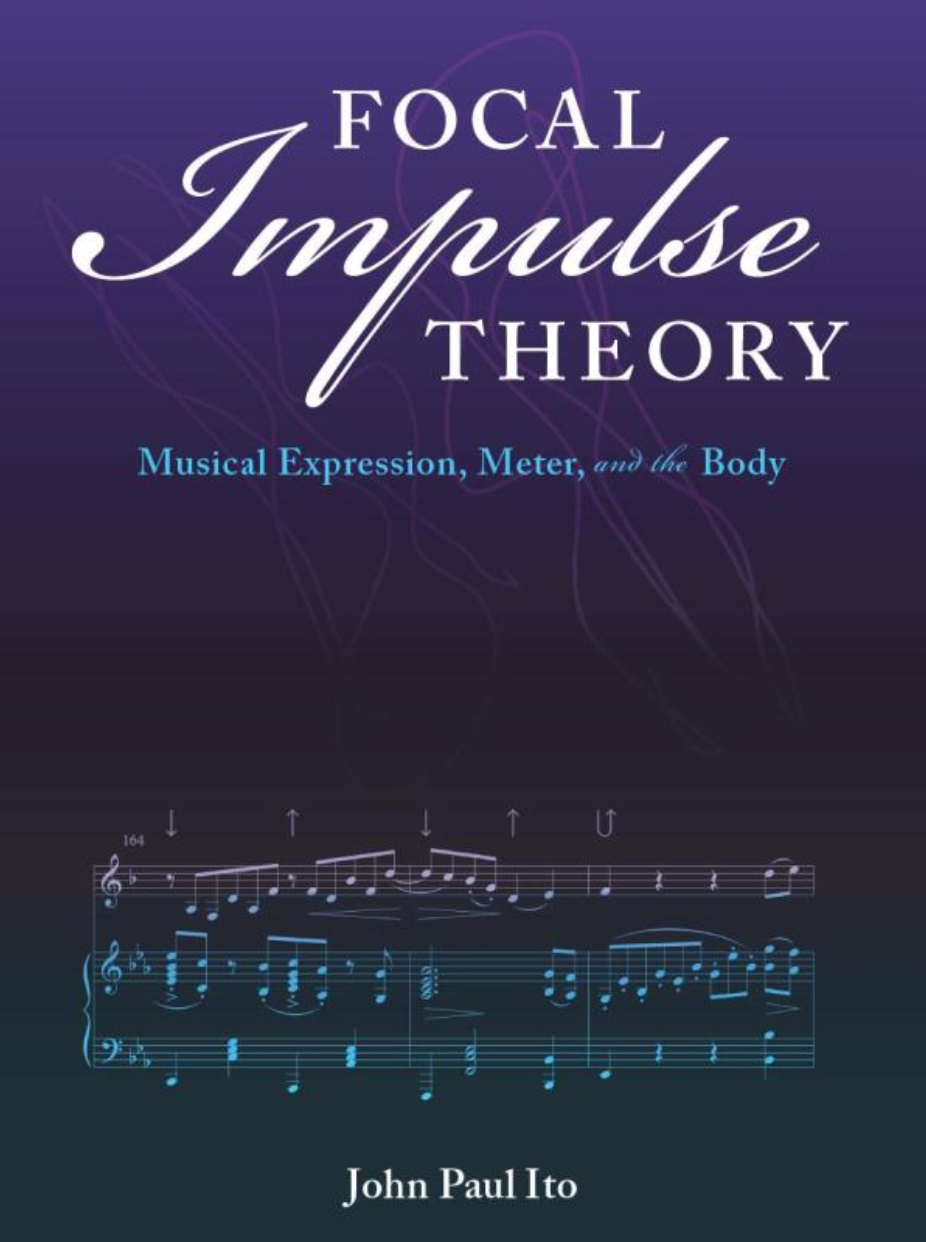Publications:
Book
Focal Impulse Theory: Musical Expression, Meter, and the Body. Indiana University Press, 2021, in the series Musical Meaning and Interpretation, edited by Robert S. Hatten.
Peer-Reviewed Journal Articles and Book Chapters
“Repetition without Repetition: How Bernstein Illumines Motor Skill in Music Performance,” 2015, in Anticipation: Learning from the Past, ed. Mihai Nadin, Cognitive Systems Monographs, vol. 25, 257-268. Cham, Switzerland: Springer.
“Johann Michael Sailer and Beethoven,” 2014, in Bonner Beethoven-Studien 11, ed. Bernhard R. Appel, Joanna Cobb Biermann, and Julia Ronge, 83-91. Bonn: Beethoven-Haus Bonn.
“Koch's Metrical Theory and Mozart's Music: A Corpus Study,” 2014, Music Perception 31.3, 205-222.
“Focal Impulses and Expressive Performance,” 2013, in Proceedings of the 9th International Symposium on Computer Music Modeling and Retrieval, ed. M. Aramaki et al., Lecture Notes in Computer Science, vol. 7900, 480-489. Berlin: Springer.
“Spiritual Narratives in Beethoven’s Quartet, Op. 132,” 2013, Journal of Musicology 30.3, 330-368.
“Hypermetrical Schemas, Metrical Orientation, and the Prototype Category,” 2013, Journal of Music Theory 57.1, 47-85.
“Repetition without Repetition: Bernsteinian Perspectives on Motor Learning for Musicians,” 2013, College Music Symposium 51.
“On Music, Mathematics, and Theology: Pythagoras, the Mind, and Human Agency,”2011, in Resonant Witness: Conversations between Music and Theology, ed. Jeremy Begbie and Steven Guthrie, 109-134. Grand Rapids, MI: Eerdmans.
Review of Eric Chafe, Analyzing Bach Cantatas, in Current Musicology 70 (2000): 141-157.
As second author with Philip Gleckman. “Phase Space Calculation of Bend Loss in Rectangular Light Pipes.” In Nonimaging Optics: Maximum Efficiency Light Transfer, ed. Roland Winston and Robert L. Holman, 163-168. Belllingham, WA: SPIE, 1991.
Reviews
Review of Scott Murphy, ed., Brahms and the Shaping of Time, in Intégral 33 (2019):93-103
Review of Eric Chafe, Analyzing Bach Cantatas, in Current Musicology 70 (2000):141-157.
Conference Presentations and Invited Talks
“Performing a Syncopated Hemiola and Its Cousin in Brahms,” Performance and Analysis Interest Group meeting, Society for Music Theory Annual Meeting, Columbus, OH, November 2019.
“Brahms and the 1.5-Length Bar,” Society for Music Theory, San Antonio, TX, November 2018.
“Bach, Rotational Form, and the Galant,” Music Theory Society of the Mid-Atlantic, Wayne, NJ, March 2018.
“Hierarchical Motor Organization in Violin Performance: An Initial Study,” with second author Heather L. Rusiewicz, Local Research Session, Eastman/University of Rochester/Cornell/Buffalo Music Cognition Symposium, Rochester, NY, April 2017.
“Cultural and Individual Particularity On the Canvas of the Metrical Hierarchy,” Making Time in Music, Oxford, United Kingdom, September 2016.
“Brahms, Meter, and Imagined Agency,” Semiotic Society of America, Pittsburgh, PA, October 2015.
“Motor Organization of Violin Bowing: Meter, Temporal Hierarchy, and Connections with Speech,” presentation to the Latash Group, Department of Kinesiology, The Pennsylvania State University, April 2015.
“Nascent Hypermeter in Bach: The Development of Style and of Perception,” European Music Analysis Conference (EuroMAC), Leuven, Belgium, September 2014.
“Performing Metrical Dissonance,” Society for Music Theory, Charlotte, NC, November 2013.
“Performing Metrical Dissonance,” Performance Studies Network Second International Conference, Cambridge, United Kingdom, April 2013.
“Repetition without Repetition: Bernsteinian Perspectives on Motor Learning for Musicians,” Convocation, School of Music, Carnegie Mellon University, October 2012.
“Focal Impulses and Expressive Performance,” 9th International Symposium on Computer Music Modeling and Retrieval, London, June 2012.
“Hypermetrical Analysis and Music-Theoretical and Linguistic Accounts of Cognition," Eastern Illinois University, February 2011.
“Beethoven’s Worldviews and the Quartet Op. 132,” Forum on Music and Christian Scholarship, South Bend, IN, February 2009.
“Analysis, Categorization, Tonality and Atonality,” Music, Language, and the Mind, Medford, MA, July 2008.
“Hypermetrical Schemas, Conflicting Theories, and the Radial Category,” Indiana Theory Symposium, Bloomington, IN, February 2008.
“What Performing Musicians and Motor Control Scientists Can Learn from Each Other,” Science Hall Colloquium, Lawrence University, March 2006.
“Elegant Mathematics, Cognition, and Scientific Investigations of Tonality,” invited colloquium, Music Theory and Cognition Program, Northwestern University, February 2006.
“A Theory of Motor Coordination in Performers of Common-Practice Music,” 8th International Conference on Music Perception and Cognition, Evanston, IL, August 2004.
“Reading Shaping Time,” invited contribution to plenary session, New England Conference of Music Theorists, Boston, April 2004.
“Performance, Perception, and the Experiential Commensurability of Musical Timescales,” University of Michigan, March 2004.
“A Theory of Motor Coordination in Musical Performance and Some Interpretive Applications,”t Washington University in St. Louis, February 2004.
“The Coordination of Motor Behaviour in Performance as a Source of Musical Gesture,” International Conference on Music and Gesture, sponsored by the European Society for the Cognitive Sciences of Music, the Society for Music Analysis, and the Society for Education, Music, and Psychology Research, Norwich, United Kingdom, August 2003. Richard Ashley read this paper for me, a family emergency having prevented me from attending the conference.
“Impulse Structure in Tonal Music: Coordination of Motor Behavior and Sonic Consequences,” University of California at Santa Cruz, March 2003.
“Swinging Impulse Coordination as a Source for Swing Rhythms,” 6th International Conference on Music Perception and Cognition, Keele, United Kingdom, August 2000. The talk discussed aspects of a substantially longer paper, published under the same title on the CD-ROM Proceedings of the Sixth International Conference on Music Perception and Cognition ed. Chris Woods, Geoff B. Luck, Roger Brochard, Susan A. O’Neill, and John A. Sloboda (2000).






